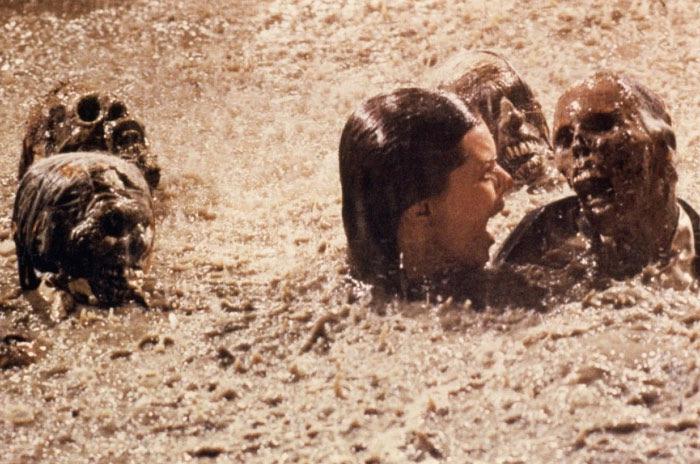The 1982 horror classic “Poltergeist,” directed by Tobe Hooper and produced by Steven Spielberg, is renowned for its spine-chilling storyline and groundbreaking special effects. However, one of the most enduring and eerie aspects of the film lies not in its plot but in the behind-the-scenes decision to use real human skeletons during its production. This controversial choice has become a focal point of Hollywood lore, sparking debates and adding to the film’s mystique. This article delves into the unsettling truth behind the use of real skeletons in “Poltergeist,” exploring the reasons, reactions, and lasting impact of this macabre decision.
The Decision to Use Real Skeletons
Practicality and Cost
In the early 1980s, the use of realistic props was a significant challenge for filmmakers. Special effects makeup artist Craig Reardon, who worked on “Poltergeist,” revealed that the decision to use real skeletons was driven primarily by practicality and cost. At the time, producing high-quality, realistic fake skeletons was expensive and time-consuming. Real skeletons, on the other hand, were readily available and cheaper to obtain. According to Reardon, real skeletons have been used in films for years due to their affordability and authenticity.
Authenticity and Realism
Another reason for using real skeletons was the desire for authenticity. The filmmakers wanted the scenes to be as realistic as possible, especially the climactic pool scene where the skeletons emerge from the muddy water. The use of real bones added a level of detail and believability that artificial props might not have achieved. This commitment to realism, however, came with unforeseen consequences.
The Infamous Pool Scene
Filming the Scene
One of the most iconic and terrifying scenes in “Poltergeist” is the pool scene, where JoBeth Williams’ character, Diane Freeling, falls into a pool filled with skeletons. The scene required Williams to perform in a water-filled set surrounded by skeletons, which she later discovered were real. The revelation that she had been in close contact with actual human remains added a layer of horror to the already intense filming experience.
Actor Reactions
The use of real skeletons was not disclosed to the actors beforehand, leading to shock and discomfort when they found out. JoBeth Williams recounted her reaction in interviews, expressing her unease upon learning that the skeletons were real. This revelation added to the eerie atmosphere on set, as the cast and crew grappled with the ethical implications of using human remains for entertainment.
Ethical and Cultural Implications
Ethical Concerns
The decision to use real skeletons in “Poltergeist” raises significant ethical questions. The use of human remains for artistic purposes can be seen as disrespectful and exploitative. While the practice was not uncommon in Hollywood at the time, it has since become a topic of debate, with many arguing that it shows a lack of respect for the deceased and their families.
Cultural Sensitivity
Using real human skeletons also touches on cultural sensitivities regarding the treatment of the dead. Different cultures have varying beliefs and practices surrounding death and the handling of human remains. The use of real skeletons in a horror film could be seen as culturally insensitive, particularly to those who hold strong beliefs about the sanctity of the human body after death.
The “Poltergeist” Curse
Mysterious Deaths and Accidents
The use of real skeletons in “Poltergeist” has often been cited as a contributing factor to the so-called “Poltergeist Curse.” This term refers to the series of unfortunate events and untimely deaths that befell several cast members and crew after the film’s release. The most notable tragedies include the murder of Dominique Dunne, who played the eldest daughter, Dana Freeling, and the death of Heather O’Rourke, who portrayed the young Carol Anne, from a medical condition.
Supernatural Speculations
The eerie events surrounding the “Poltergeist” franchise have fueled speculation about a supernatural curse. Some believe that the use of real skeletons disturbed the spirits of the deceased, leading to the misfortunes that plagued the cast and crew. While there is no concrete evidence to support these claims, the idea of a curse has become an integral part of the film’s legacy, adding to its mystique and horror.
Lasting Impact on Hollywood
Changes in Industry Practices
The controversy surrounding the use of real skeletons in “Poltergeist” led to changes in industry practices. As special effects technology advanced, the need for real human remains diminished. Modern films now rely on high-quality replicas and digital effects to achieve realism without ethical concerns. The “Poltergeist” case serves as a reminder of the importance of ethical considerations in filmmaking.
Influence on Horror Genre
The use of real skeletons in “Poltergeist” has had a lasting impact on the horror genre. It highlighted the lengths to which filmmakers would go to achieve realism and provoke fear. This commitment to authenticity has influenced subsequent horror films, pushing directors and special effects artists to find innovative ways to create believable scares while respecting ethical boundaries.
Conclusion
The decision to use real skeletons in the 1982 movie “Poltergeist” remains one of Hollywood’s most controversial and eerie tales. Driven by practicality and a desire for authenticity, this choice added a layer of realism to the film while raising significant ethical and cultural questions. The resulting “Poltergeist Curse” and the film’s lasting impact on the horror genre underscore the complex interplay between art, ethics, and the supernatural. As we reflect on this haunting chapter in film history, it serves as a cautionary tale about the importance of respecting the dead and the ethical responsibilities of filmmakers.



